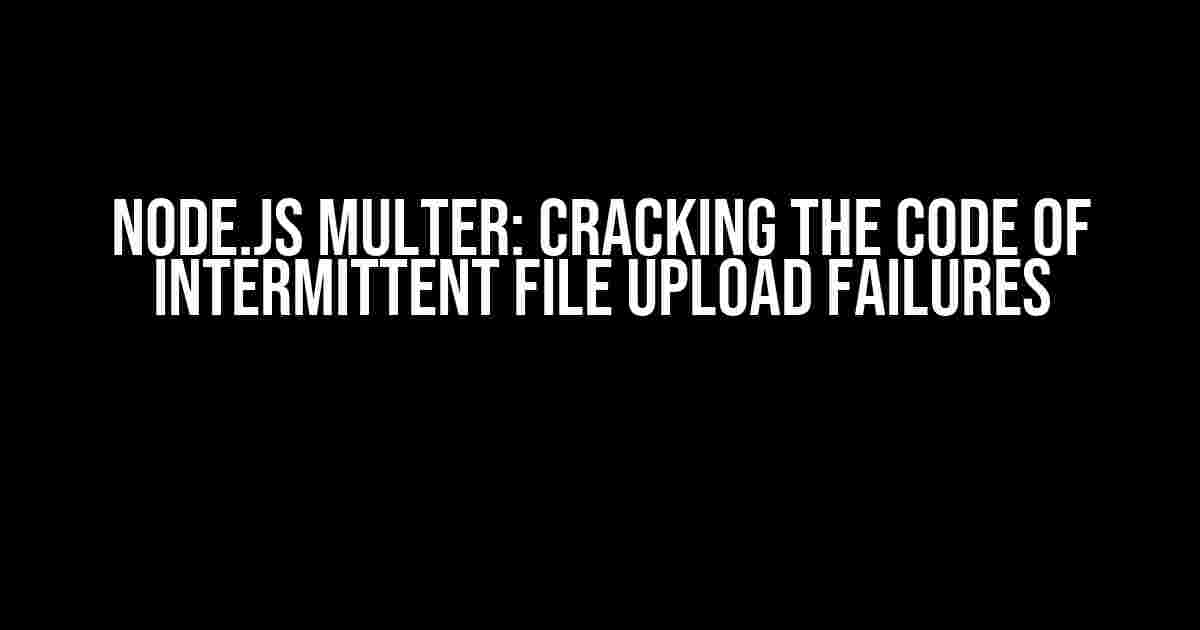Are you tired of dealing with frustrating file upload failures in your Node.js application? Are you wondering why your files sometimes upload smoothly, while other times they seem to vanish into thin air? You’re not alone! In this article, we’ll dive into the troublesome world of Node.js Multer and uncover the reasons behind those pesky intermittent file upload failures.
The Mysterious Case of Disappearing Files
When using Multer, the popular middleware for handling multipart/form-data requests, you might encounter an issue where files fail to upload to your server randomly. This can be infuriating, especially when you’re working on a critical project with tight deadlines. The worst part? It’s hard to pinpoint the exact cause, leaving you feeling like a detective trying to solve a mysterious crime.
So, what’s behind these intermittent file upload failures? Let’s examine some common culprits:
- Network connectivity issues: A poor internet connection can cause files to fail uploading, making it seem like a random problem.
- Server-side errors: Database connectivity problems, server load, or incorrect configurations can all contribute to file upload failures.
- Client-side issues: Browser limitations, incomplete file uploads, or incorrect MIME types can also cause problems.
- Multer configuration mistakes: Misconfigured Multer settings, such as incorrect storage options or file size limits, can lead to file upload failures.
Debugging Techniques to Uncover the Truth
To get to the bottom of these issues, you’ll need to employ some detective work. Here are some essential debugging techniques to help you identify the root cause:
- Check server logs: Inspect your server logs to see if there are any error messages indicating what went wrong during the upload process.
- Verify network connectivity: Ensure that your network connection is stable and working correctly. You can use tools like
curlorwgetto test your connection. - Use browser developer tools: Open your browser’s developer tools (F12 or Ctrl + Shift + I) and inspect the network requests to see if any errors occur during the upload process.
- Implement error handling: Catch and log errors using Multer’s built-in error handling mechanisms, such as the
onErrorfunction.
Multer Configuration: The Key to Success (or Failure)
Multer’s configuration plays a vital role in determining the success or failure of file uploads. Let’s take a closer look at some crucial settings that can impact your uploads:
| Setting | Description |
|---|---|
| dest | Specifies the directory where files will be stored. |
| fileFilter | Controls which files are accepted based on MIME types, file extensions, or other criteria. |
| limits | Sets file size limits, both for individual files and the overall request. |
| storage | Specifies the storage engine used to handle file uploads (e.g., disk storage, AWS S3, etc.). |
Here’s an example of a basic Multer configuration:
const multer = require('multer');
const upload = multer({
dest: './uploads/',
fileFilter(req, file, cb) {
if (file.mimetype !== 'image/jpeg' && file.mimetype !== 'image/png') {
return cb(new Error('Only JPEG and PNG files are allowed'));
}
cb(null, true);
},
limits: {
fileSize: 1024 * 1024 * 5, // 5MB
files: 10,
},
storage: multer.diskStorage({
destination(req, file, cb) {
cb(null, './uploads/');
},
filename(req, file, cb) {
cb(null, `${Date.now()}${path.extname(file.originalname)}`);
},
}),
});
Error Handling: The Unsung Hero
Error handling is crucial when dealing with file uploads. Multer provides a built-in onError function that allows you to catch and handle errors. Here’s an example:
const upload = multer({
// ... previous configuration ...
onError(err, req, res, next) {
if (err) {
console.error(err);
res.status(500).send({ message: 'Error uploading file' });
}
next();
},
});
By catching errors and logging them, you can identify the root cause of the problem and take corrective action.
Conclusion: Unraveling the Mystery of Intermittent File Upload Failures
In conclusion, solving the mystery of intermittent file upload failures in Node.js Multer requires a combination of debugging techniques, configuration tweaks, and error handling. By understanding the potential causes, employing effective debugging methods, and fine-tuning your Multer configuration, you can minimize the occurrence of these frustrating errors. Remember, with great power comes great responsibility – take the reins and master the art of file uploads with Multer!
Still struggling with file upload issues? Share your experiences and questions in the comments below. Let’s solve this puzzle together!
Frequently Asked Question
Struggling with intermittent file upload failures using Node.js Multer? Relax, we’ve got you covered! Here are some frequently asked questions and answers to help you resolve the issue.
Why do files not upload to the server randomly using Node.js Multer?
This could be due to various reasons such as network connectivity issues, request timeouts, or even Memory leaks in your server. Also, make sure you’re handling errors properly and logging them to diagnose the issue.
How can I troubleshoot file upload failures using Node.js Multer?
Start by checking your server logs for errors, use a debugger to step through your code, and verify if the request is reaching your server. You can also use tools like Postman or cURL to simulate the file upload request.
Can I set a retry mechanism for file uploads using Node.js Multer?
Yes, you can use a retry mechanism like async-retry or retry-axios to implement exponential backoff retries for your file uploads. This can help in cases where the upload failure is due to temporary network issues.
How do I handle large file uploads using Node.js Multer?
To handle large file uploads, you can use Multer’s built-in support for streaming uploads. This allows you to process the file in chunks, reducing memory usage and making it easier to handle large files.
Can I use Node.js Multer with a load balancer or cloud storage?
Yes, you can use Node.js Multer with a load balancer or cloud storage like AWS S3. Just make sure to configure your load balancer to handle multipart/form-data requests and Multer to upload files directly to your cloud storage.
I hope this helps!

